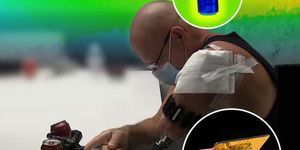Real-Life Sci-Fi: Self-Healing Metal Discovered
A research team of scientists from the U.S. Department of Energy and Texas A&M University has discovered a new phenomenon straight from science fiction: self-healing metals that can fuse back together after cracking.
"What we have confirmed is that metals have their own intrinsic, natural ability to heal themselves, at least in the case of fatigue damage at the nanoscale," said study co-author Brad Boyce. “This was absolutely stunning to watch first-hand.”
The implications of this discovery are vast, with possibilities for engines, bridges and airplanes to self-heal cracks and other damages that naturally accumulate over time. In fact, the gradual failure of metals through accumulated cracks known as “fatigue” accounts for up to 90% of service failures of metal pieces and structures.
Study co-author Michael Demkowicz predicted the phenomenon of intrinsic self-healing a decade ago while working as an assistant professor at MIT. Thanks to findings from computer simulations, Demowicz uncovered and published his hypothesis that cracks in metal could potentially fuse back together of their own volition when in certain conditions.
The theory was inadvertently confirmed when the self-healing behavior spontaneously arose during an experiment at the Center for Integrated Nanotechnologies, a Department of Energy facility.
Paper authors Khalid Hattar and Chris Barr were leading an experiment to evaluate the formation and spread of cracks through a piece of platinum. In the experiment, the platinum is subject to stress, with pulling on the ends of the metal 200 times per second. However, about 40 minutes into the experiment, one end of the crack fused back together as if it had never existed — a process that they described as “crack flank cold welding,” caused by a combination of local stress and grain boundary migration. Eventually, the crack reappeared in a different part of the platinum.
"We certainly weren't looking for it," Boyce said.
Boyce contacted Demkowicz to let him know that his theory had been confirmed. "I was very glad to hear it, of course," Demkowicz said. He then went on to recreate the experiment via computer simulation, which confirmed that the real-life phenomenon matched with the theoretical one he’d predicted via computer model ten years prior.
Boyce reiterated that, thus far, the behavior has only been observed in very select circumstances. “We don’t know if this can also be induced in conventional metals in air,” he said. He and Demkowicz both confirmed the need for further experiments to explore the limits and possibilities of the new discovery. The finding challenges “the most fundamental theories on how engineers design and evaluate fatigue life in… materials,” the paper asserts.
Sources: Nature; ScienceDaily; Nature (2017)








